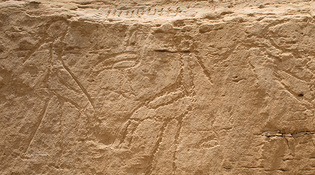 loading
loading
FindingsAnd now, a message from your pharaohYale archeologists find a 5,200-year-old “billboard” in Egypt.  Alberto Urcia, Elkab Desert Survey ProjectView full imageOn a rock outcrop outside the Egyptian village of El-Khawy, John Coleman Darnell, professor of Near Eastern Languages and Civilizations, and an international research team found the ancient equivalent of a billboard. Carved into a stone panel more than two feet high were images of animals: two saddleback storks, with a bald ibis between them, and to their right a bull’s head on a pole—signs used in “the earliest hieroglyphic script,” says Darnell. Monumental public signage was a trademark of ancient Egyptian culture, but this carving, at some 5,200 years old, is by far the earliest example known. Darnell says the archaeologists were “absolutely flabbergasted” by its size. The images, sited at an ancient crossroads, were clearly meant to be seen by passersby. (For modern viewers, the researchers are documenting all their finds in three-dimensional high-def with technology developed at Yale.) Their presence suggests that hieroglyphs were adopted more quickly and publicly than was previously known. What does the billboard say? It might be reminding travelers of the reach of their government. The same symbols were often used in later Egyptian depictions of the solar cycle, a central emblem of the king’s divinity and earthly authority. Says Darnell: “At the most basic level, this inscription could be a nice way of proclaiming royal control over the area and letting travelers know that they’re being watched.”
The comment period has expired.
|
|